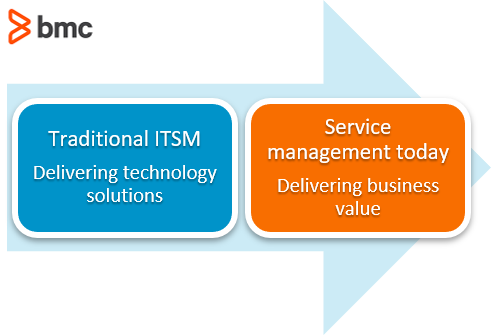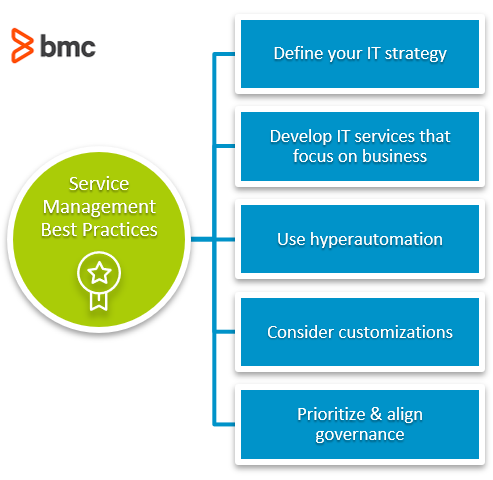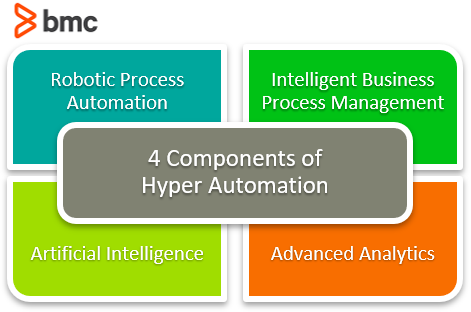Digital transformation requires organizations to:
- Accurately analyze their IT service management (ITSM) capabilities and maturity
- Identify systematic gaps
- Define a practical roadmap to realize their strategic vision
Following best practices on ITSM implementation can help organizations improve their ability to deploy, integrate. and manage their ITSM tools and systems.
Since service management is a critical element of the wider digital transformation strategy, any possible improvement should be seen as a strategic shift—not just a technology-enablement project. Any investment and effort in the service management domain should focus on:
- Operational excellence
- End-user experience
- Process efficiency
- Transparency
- Innovation
IT departments and users often debate over the best framework, technology solution, implementation strategy, and other nitty gritty details on managing IT services. However, improvements in ITSM often require business executives and IT to take a step back and observe the opportunities of improvement and the associated challenges from a strategic perspective as they aim for their digital transformation goals.

How do we achieve these overarching goals of digital transformation and IT service management?
The following strategic ITSM best practices can ensure that IT delivers true value to the business and users.
1. Define an exhaustive IT strategy
This first best practice is all about your vision and strategy.
Develop a comprehensive vision and roadmap for your ITSM initiatives. Think through the implementation phase and user response, and allow provisions for potential improvements down the line.
Follow a systematic approach to measuring and guiding the progress of your ITSM implementation projects: find the success factors and define the KPIs, metrics, guiding framework, and the desired state at every stage of the implementation.
Any roadmap effort should cover all three domains of IT in service management, business operations as well as the enterprise-wide strategic vision:
- Front-end IT. The technology systems, solutions, and capabilities that enable service design, service operations, and service transition. Examples include a self-service portal for Service Desk applications.
- Middle IT. The processes and operational workflows defined by frameworks and automation capabilities.
- Back-end IT. Administrative and data capabilities such as analytics, monitoring, business intelligence and AI that enable IT and business executives to make and enforce well-informed business decisions.

2. Develop business-focused IT services
Service management allows business organizations to transform their operations by taking advantage of advanced technology solutions. Digital transformation requires technologies to be not only more efficient, but also support business-focused needs of the organization.
Understanding how IT services are delivered and how users interact with the technology can help organizations map and correlate their ITSM strategies to business outcomes.
For instance, adopting a unified process to track and analyze configuration updates and IT incidents can help you understand how IT infrastructure changes impact IT service availability and, hence, business productivity.
3. Use hyperautomation
Hyperautomation is a popular ITSM trend that combines a range of automation and intelligence capabilities to perform tasks that otherwise require human intervention. Sophisticated technology solutions help create a “digital twin” of the ITSM organization that is responsible for key ITSM tasks such as:
- Service discovery
- Analytics
- Monitoring
Hyperautomation is all about continuous intelligence. In the domain of ITSM, it’s focused on deriving insights from the IT environment, service delivery, and user behavior. These insights are delivered in real-time and work as a stream of continuous intelligence that can be used across all subset domains of the ITSM organization.
For instance, an integrated platform that centralizes management of repeatable ITSM processes can help ITSM organizations to:
- Standardize configurations
- Enable real-time asset discovery
- Establish closed loop governance and regulatory compliance processes based on real-time user feedback

4. Consider customizations vs off-the-shelf
Many organizations invest in new technologies and expect them to work well off-the-shelf. IT departments generally prefer to deploy technology solutions the way they came out of the box, since any customization is likely to introduce integration concerns, complexity, and bugs—an operational and maintenance nightmare for IT.
However, the time and effort saved with “out of the box” implementation doesn’t always materialize into tangible business value.
Even the most well-defined technology solutions must be configured and often customized to meet specific business, technology, or service requirements. These unique influences must be considered when:
- Investing in new technologies
- Employing in-house talent
Business leaders, IT executives, and other change agents should therefore support efforts that ensure all ITSM technology investments deliver positive business impact, despite the higher implementation cost and resources incurred.
5. Prioritize & align governance
Organizations operating on a limited budget and resources tend to overlook the importance of investing in governance areas. But, inadequate governance gives rise to discrepancies between the planned ITSM framework and policy implementations—and what actually happens.
For instance, users find ways to bypass organizational protocols for using a new tool or solution, often for two reasons:
- In favor of convenience
- To access technology capabilities lacking in the company’s existing solution portfolio
This practice leads to Shadow IT and misalignment of IT service management resources to the business objectives.
Governance is also seen as an overhead—a cost center instead of a profit center, like other domains of service management. However, it’s important to understand the role of governance in ITSM, in particular how the balance between accountability and leverage can empower ITSM users.
Companies can avoid this nightmare by training and encouraging employees to:
- Adopt the right policies and framework guidelines in their routine work
- Take advantage of the flexibilities therein to adapt framework implementation and alternate technology solutions through a systematic approval from IT.
(Manage IT like a product, not a cost center.)
Service management best practices
Because service management is such an encompassing and necessary domain of IT and business, there are numerous best practices that might, or might not, work best for your organization.







